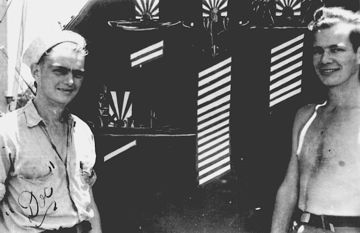
Being discharged in 1946 did not end my naval experience. Indeed, as all my children and grandchildren know Navy events and shipmates are very important to me to this day. I want to end this section on the Navy with some random facts, figures, and photos.
I made some life-long friends on the Newcomb and I want to introduce you to two of them:
I have mentioned Roy Dockray before; here we are in June 1945, at Kerama Retto, standing by the fire-control director on the flying bridge. Note our score tally: from left to right—1 battleship, 2 submarines, 14 aircraft, 7 major invasions.
We were each other’s best man, and we have kept in close touch for 50+ years and still see each other occasionally. Our mothers became good friends. Doc established a successful office furniture business and now spends most of his time on the golf course in Florida.
Norman Kohl made good use of the GI Bill after the war and was very successful in the dairy products business. Collie and I loved him and his wife Marilou; both now deceased. This photo was taken in Honolulu prior to the Saipan invasion.

Roy Dockray and Nate Cook.
In the summer of 1946 Doc and I decided to take a week’s auto trip to visit Norm at his home in Springfield, Ohio and also to visit Gene Sharpe in Roanoke, VA. In those days we didn’t know much about planning ahead, so we sent a telegram to Norm saying “Stand by for a ram” assuming he would realize that we were about to descend upon him. We arrived at his folks’ home to find his mother in a dither. Norm and Marilou had been married the day before the wire arrived and Norm’s mother didn’t know how to contact him. She had thought that two of his Navy buddies were sending him a real “ram” (sheep or goat) as a joke wedding present! We did find Gene and his very pregnant wife Maggie at home. Our trip, in Doc’s 1931 Model A Ford was great fun.
Warfare aboard a WWII destroyer was different from many types of warfare. There was no place to hide. There were no foxholes. There was no armor. There was no place to run to. We all knew very well, having seen other ships sunk and damaged, that our best chance of staying alive was by fighting. And fighting was a joint effort of all aboard. We were well trained and by and large we did our jobs. Of course it was possible for an individual not to do his job and thereby endanger the whole ship. But it was very difficult for anyone to do more than his job—an heroic action.
A number of medals were awarded to members of the crew for their actions—mostly to officers. But in most instances these men were just doing their jobs!
After the war the Newcomb was awarded the coveted Navy Unit Citation by James Forrestal, then Secretary of the Navy. I will reproduce that citation because it speaks to all of us who just did our jobs.
“For outstanding heroism in action against enemy Japanese forces in the Saipan-Tinian operations, May 29 to August 5, 1944; Palau, September 6 to October 1, 1944; the Battle of Surigao Strait, October 24–25, 1944; Iwo Jima, February 10 to March 10, 1945; and Okinawa, March 21 to April 7, 1945. Operating in the face of continued and persistent air attacks throughout five major campaigns, the U.S.S. NEWCOMB blasted Japanese shore emplacements, screened our attacking transports and effectively laid support barrages for amphibious assaults. As the Leader of Destroyer Squadron FIFTY SIX in the historic Battle of Surigao Strait, she spearheaded a three-section night torpedo attack, boldly closing the battleship YAMASHIRO‘s terrific broadsides to aid in sinking the powerful man-o’-war with accurate torpedo salvos. In retiring, she went alongside the stricken A. W. GRANT to evacuate casualties and take the disabled ship in tow. At Iwo Jima, the NEWCOMB covered our minesweepers in the pre-attack sweep of the landing beaches and scored a probable kill on her second submarine. Culminating her brilliant combat service in a furious engagement with seven enemy suicide planes determined to destroy her, the NEWCOMB, staggering from the first suicide crash and slowed by loss of steam, shot down a second plane and was immediately smashed amidships by a third. With top-hamper and machinery spaces blown into a tangled mass of rubble, with smoke and flames billowing 1000 feet above her and the bridge the only structure intact above the water line, she fought on relentlessly with her remaining guns in manual control to blast three more attackers into the sea an damage the last Kamikaze. Superbly handled by valiant officers and men, the NEWCOMB has added new luster to the finest traditions of the United States Naval Service.”
Because I was the first shipmate to have a computer, I volunteered to be the keeper of our mailing list and other related information. We have worked to try to find more of our shipmates. Right now we have about 180 names on the mailing list, but 60 of these are widows or children. Each year we find a few more shipmates, but we are all getting older, and each year we loose a few. Whenever we learn of a death we send flowers from “The Shipmates and Wives of the USS Newcomb.”
In addition to maintaining lists, since 1985 I have written the Newcomb Newsletter 2–3 times a year. Shipmates send us information, I write the letter, printout a set of mailing labels, and Collie does most of the rest. She has become a major actor on the Newcomb scene, admired and loved by my shipmates!
The Newsletter and reunion activities take time and effort, but are very, very rewarding for both of us. I just hope that we can keep up our Navy activities for some time to come.